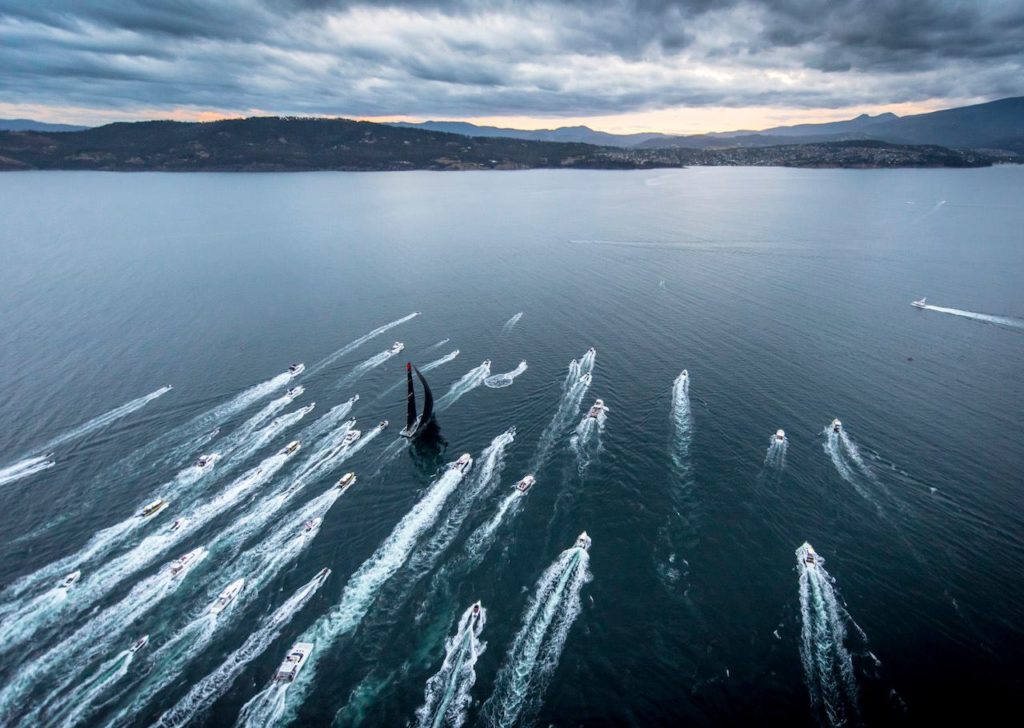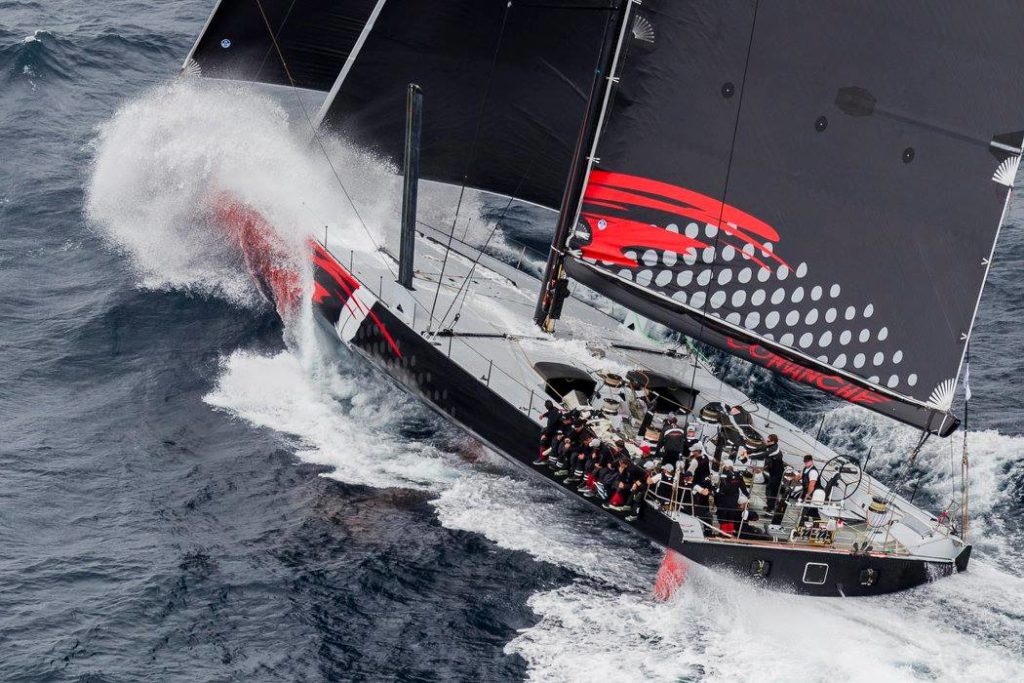
Paul Clitheroe’s TP52, Balance, of Australia, was declared the Rolex Sydney Hobart Race’s overall winner on corrected time, but it is often not the overall winner, but the battle of the biggest and fastest for line honors that gets the most attention. The 2015 Rolex Sydney Hobart Race was filled with breakdown after breakdown and upset after upset, and Comanche captivated the media’s attention battling through breakdown.
We sat down with Comanche skipper Ken Read to talk about the race that almost wasn’t and find out how Comanche turned an abandoned race into a line honors victory.
What did you do to make the boat better?
There’s a different bulb, a different weight package, more water ballast, different sail sizing and different rake. We sail it differently too. We have fewer crew, fewer sails and different sail shapes. Besides all that, it’s the same boat as a year ago.
What were the weaknesses?
Every boat has an Achilles’ heel, and ours was 8 knots and lump. We’re not going to eliminate our weakness, but we had to shrink it without degrading the boat’s good features. We wanted to get better upwind, so we changed some weight in the boat and changed how we deal with our daggerboards. Now the boat is a rocket ship upwind. We had to improve that Achilles’ heel to get it down from 8 to 6 knots, and that’s a big window. Our rating certificate went from about 32.5 tons to 31. That’s a big chunk, and if you reposition some of the permanent weight within the boat without taking away from the power-reaching capabilities of the boat, then you’re on to something, and we achieved that.
Once you were confident you’d be in for a good blow in the first 24 hours, what was the strategy?
We planned our inventory accordingly. With 20 Volvo Ocean Race vets on board, we know how to deal with cold fronts and frontal passages. Whenever we get into maneuvers like this, each of us goes into our daysailing position. We jibed at the right time, we reefed at the right time and we got the A3 furled at the right time. We had our little furling jibs already up and ready to go. We already had a single reef and only had to go down one more reef. We nailed the front. Wild Oats tore their main because their pull-down line got jammed and they couldn’t get it down. They just flogged it to death. Stan came up afterward and said we gained 10 miles on the closest guy because we just nailed it. To knock off all the sail changes like we did was the coolest moment of the race. When it was blowing 40 and we couldn’t even see through the rain, I was just laughing and thinking, “Wow, that was really impressive, guys.”
Take us through the daggerboard failure that almost cost you the race.
It was exactly one hour after frontal passage. We were sailing upwind with a J3 and double-reefed main, and it’s not big waves yet because we’re only an hour into the strong southerly. We had our daggerboard in its safe position, which means not having it all the way down to the bearing; we had it up 3 or 4 feet to take some side force off. We were going 13 knots, which is normal. Tony Mudder was driving and I was sitting in the nav station when all of a sudden [there was] a big bang, and then the horrible crunching sound of carbon fiber.
I immediately knew it was the daggerboard and yelled for Tony to slow down and try and stop the boat. He got it down to 7 or 8 knots right away. It was pitch black, it was the leeward daggerboard, and the problem was our up-down system is all ropes — we don’t have a cascading carbon post; it’s all done with ropes — so the broken part below the boat was attached with two Spectra ropes, which aren’t going to break. All of a sudden it was “bang, bang, bang” into the bottom of the boat, and I realized the daggerboard is fishtailing under the boat, hanging on to these ropes. I was sure the trailing edge of the daggerboard would come through the bottom of the boat, because it’s really sharp.
The knot on the end of the down line on the daggerboard is right at the end of the rope, and it was smashed up against the jammer. Nick Burridge was trying to cut it, but had to cut the knot apart to get to the rope. Casey Smith was at the daggerboard case down below trying to cut the up line, which he can barely get his hand on. Finally, all of a sudden, “bang, bang,” and then a thud as it clipped the rudder on its way out the back of the boat.
Tony was clearly having a hard time steering, and my guess is he had the helm hard over one way or the other, and the daggerboard whacked the front, grabbed the trailing edge on the way by, and then [he] violently tried to straighten it out. What it did was break the tiller arm away from the post that attaches the two tiller arms together. But we didn’t know at the time. Tony called that the rudder is gone, so I handed my harness clip to Kelvin Harrap and half-jumped over the back of the boat to see if there was a rudder.
I could see the rudder with my flashlight, so I got back on deck, ran below and told Casey. He was like, “Here’s the problem.”
The tiller arm was facing 180 degrees backward. I jumped back up on deck, got off the back of the boat, and saw that the rudder was facing backward. At that moment I thought, “We’re screwed.”

It was a surreal moment. I’m down one headlamp because I spiked mine onto the deck and it exploded into a thousand pieces. Kristy was half-crying, and everyone was pissed because those were Comanche conditions. I explained the situation to the guys and we just started heading back to Sydney. Once we started going downwind, the rudder straightened itself out, and that’s when the guys started taking out the toolboxes.
We sailed downwind for a bit while they were working on it, and then we turned to port so the starboard rudder was in the water and the port rudder had very little drag on it. Essentially we were hove to on port tack at that stage. They got a tiny bit of it connected, so we jibed with the head of the mainsail and went hove to on starboard tack with the bad rudder still in the water and somewhat connected. Once they were happy with the repair, the main went up to two reefs, the J3 came back out, and off we went. When you have furling sails and an exceptional lazy jack system, you can pretty much do anything without damaging the sails. We ended up losing about 30 miles total over the course of an hour.
What was the repair?
The tiller arm connects to a bar that goes to the quadrant. The bar was sheered off. It was a 2-inch threaded stainless rod that snapped. What they had to do was take what was left of the threads, which was only three threads, find a nut, and then make the threads usable again in order to be able to tie it back into the tiller arm. It was getting that little piece, those three threads, functional enough. The rudder toe-in was about 6 degrees off where it should have been, and the rudder was pretty mangled, so we were waiting for it to snap.
We didn’t know if we had any hull damage. That was the big chance we took — not knowing if the hull was compromised. The next day, on port tack, we hung a guy over the side and realized there were only a few dings.
In retrospect, had we done it over again, we would have rolled the jib away, pegged it head to wind, and tried to stop the boat immediately rather than trying to keep steerage. Just stop the boat so the debris goes forward, sideways or whatever, but just not toward the rudder.
Knowing the boat was compromised and potentially had hull damage, what prompted you to carry on and finish?
One thing I said out loud was that if anything were going to break, we’d be on port tack heading for land and keep the compromised side of the boat out of the water. If the rudder broke, we had two days of port tack to play with. Secondly, the forecast was bad for the next few hours, so I thought we could get back into the race and push the guys around us and have a chance that someone else could break. Sure enough, Rambler had daggerboard problems too. Thanks to the internet, we found out that Rambler had broken 10 hours later, so that was new life to the fine yacht Comanche.









